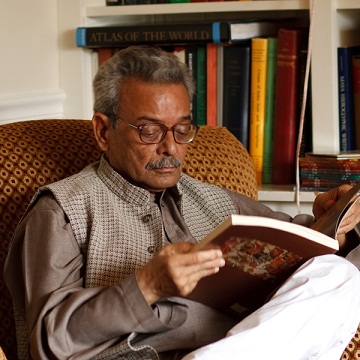
The Beacon
On Friday 25th, Shamsur Rahman Faruqi passed on in Allahabad. The polymath writer poet. culture historian and literary theorist had tested positive for COVID-19 in November and he had been discharged from a Delhi hospital after a being treated for a few days.
Death came calling; it stood at the door and claimed him. Shamsur Rahman Faruqi succumbed to the Covid 19 pandemic but he died of having lived. A life long and deep. Leave alone the multiple honours, the felicitations. His life and death, for they are one like the river and the sea, leave behind for us a legacy of embedded cosmopolitan sensibilities. His work as an aesthete rooted in an Indic tradition and open to the ecstasies of poetic visions from around the world are the legacies he leaves us to cherish and build upon.
The Beacon was privileged to share with its readers some of that great tradition he both imbibed and fostered. His correspondences with fellow poet Asif Raza exude the fragrances of a dialogic art form that is inspirational in its tragic inevitability of an ignoble oblivion in an age of digitized self-satiation. His magnum opus, The Mirror of Beauty (in English) was reviewed by Raza, again in a dialogic form, a conversation The Beacon carried as an example of the engagement between a writer and reader in which roles are reversible.
Shamsur Rahman Faruqi was a prolific writer bringing alive traditions of culture and history in ways that manifest his ability to cross the borders between the art of fiction, the disciplines of ethnography and history, evident in his monumental studies of Mir Taqi Mir and the dastango tradition that his nephews has helped bring back to life as a revolutionary art form for our times. And The Mirror of Beauty self translated, marked him off as a polymath who could produce lines such as this one:
“The whole age was her lover, sight unseen”
He was a great writer because he was also a great reader. What more can one say but echo William Butler Yeats:|
“Oh chestnut tree, great rooted blossomer,
Are you the leaf, the blossom or the hole?
O body swayed to music, O brightening glance,
How can we know the dancer from the dance?”
******
Notes --Quote from The Mirror of Beauty p 814. Penguin Books. 2013. New Delhi --Couplet from ‘Among School Children’ in The Collected Poems of W.B. Yeats. p 185. Wordworth Poetry Library1994. London 185 Shamsur Rahman Faruqi in The Beacon Mir in Chandigarh Urdu Writing Over Two Centuries On Nation, History, Culture CONVERSATION WITHOUT MAPS

Leave a Reply